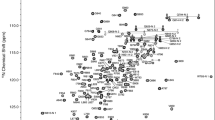Abstract
Cell adhesion molecules play a crucial role in fundamental biological processes via regulating cell–cell interactions. Nerve injury induced protein1 (Ninjurin1) is a novel adhesion protein that has no significant homology with other known cell adhesion molecules. Here we present the assignment of an 81 aa construct for human Ninjurin1 Extracellular N-Terminal (ENT) domain, which comprises the critical adhesion domain.


Similar content being viewed by others
References
Araki T, Milbrandt J (1996) Ninjurin, a novel adhesion molecule, is induced by nerve injury and promotes axonal growth. Neuron 17(2):353–361
Araki T, Zimonjic DB, Popescu NC, Milbrandt J (1997) Mechanism of homophilic binding mediated by ninjurin, a novel widely expressed adhesion molecule. J Biol Chem 272(34):21373
Bryson K, McGuffin LJ, Marsden RL, Ward JJ, Sodhi JS, Jones DT (2005) Protein structure prediction servers at University College London. Nucleic Acids Res 33(suppl 2):W36–W38
Butcher EC, Picker LJ (1996) Lymphocyte homing and homeostasis. Science 272(5258):60
Cardoso CC, Martinez AN, Guimarães PEM, Mendes CT, Pacheco AG, de Oliveira RB, Teles RMB, Illarramendi X, Sampaio EP, Sarno EN (2007) Ninjurin 1 asp110ala single nucleotide polymorphism is associated with protection in leprosy nerve damage. J Neuroimmunol 190(1):131–138
Chen JS, Coustan-Smith E, Suzuki T, Neale GA, Mihara K, Pui CH, Campana D (2001) Identification of novel markers for monitoring minimal residual disease in acute lymphoblastic leukemia. Blood 97(7):2115–2120
Christofori G (2003) Changing neighbours, changing behaviour: cell adhesion molecule-mediated signalling during tumour progression. EMBO J 22(10):2318–2323
Delaglio F, Grzesiek S, Vuister GW, Zhu G, Pfeifer J, Bax A (1995) NMRPipe: a multidimensional spectral processing system based on UNIX pipes. J Biomol NMR 6(3):277–293
Doherty P, Walsh FS (1996) CAM-FGF receptor interactions: a model for axonal growth. Mol Cell Neurosci 8(2–3):99–111
Johnson BA (2004) Using NMR view to visualize and analyze the NMR spectra of macromolecules. Methods Mol Biol 278:313–352
Jones DT (1999) Protein secondary structure prediction based on position-specific scoring matrices1. J Mol Biol 292(2):195–202
Lee HJ, Ahn BJ, Shin MW, Choi JH, Kim KW (2010) Ninjurin1: a potential adhesion molecule and its role in inflammation and tissue remodeling. Mol Cells 29(3):223–227
Li G, Herlyn M (2000) Dynamics of intercellular communication during melanoma development. Mol Med Today 6(4):163–169
Schwarzinger S, Kroon GJA, Foss TR, Chung J, Wright PE, Dyson HJ (2001) Sequence-dependent correction of random coil NMR chemical shifts. J Am Chem Soc 123(13):2970–2978
Shen Y, Delaglio F, Cornilescu G, Bax A (2009) TALOS + : a hybrid method for predicting protein backbone torsion angles from NMR chemical shifts. J Biomol NMR 44(4):213–223
Toyama T, Sasaki Y, Horimoto M, Iyoda K, Yakushijin T, Ohkawa K, Takehara T, Kasahara A, Araki T, Hori M (2004) Ninjurin1 increases p21 expression and induces cellular senescence in human hepatoma cells. J Hepatol 41(4):637–643
Wishart DS, Bigam CG, Holm A, Hodges RS, Sykes BD (1995) 1 H, 13 C and 15N random coil NMR chemical shifts of the common amino acids. I. Investigations of nearest-neighbor effects. J Biomol NMR 5(1):67–81
Zhan Y, Brown C, Maynard E, Anshelevich A, Ni W, Ho IC, Oettgen P (2005) Ets-1 is a critical regulator of Ang II-mediated vascular inflammation and remodeling. J Clin Investig 115(9):2508
Acknowledgments
This study was supported by the National Research Foundation of Korea (NRF) grant funded by Korean government (MEST) (Grant number 20110001207). This study was also supported by a grant of the Korea Healthcare technology R&D Project, Ministry for Health, Welfare & Family Affairs, Republic of Korea. (Grant number:A092006). This work was supported in part by 2011 BK21 project for Medicine, Dentistry, and Pharmacy. We thank Korea Basic Science Institute (KBSI) and National Center for Inter-University Research Facilities (NCIRF) for using their NMR machines.
Author information
Authors and Affiliations
Corresponding author
Rights and permissions
About this article
Cite this article
Lee, IG., Jang, SB., Kim, JH. et al. 1H, 13C and 15N chemical shift assignments of Ninjurin1 Extracellular N-terminal Domain. Biomol NMR Assign 7, 159–162 (2013). https://doi.org/10.1007/s12104-012-9400-3
Received:
Accepted:
Published:
Issue Date:
DOI: https://doi.org/10.1007/s12104-012-9400-3




